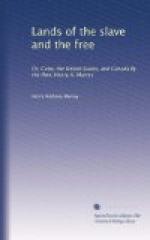The extent to which the churches in America have increased is doubtless most creditable to the community, when it is remembered that all the various denominations are supported voluntarily. Nor is their number the only point worthy of notice: the buildings themselves have all, some ecclesiastical appearance, and many of them are fine specimens of architecture. Besides which, they are always kept clean and in good order; you will never find those unsightly barns, and still less the dilapidation which is often met with in the mother land. I have myself been in a church at home where the flooring was all worn away, and gravel from the outside substituted, and where the seats were so rickety that a fall might be anticipated at any moment. The parishioners were poor Highlanders, it is true, but the owner of the soil was a man of considerable wealth.
I have, since my return to England, been into a beautiful old parish church in one of the midland counties; the building was in a most deplorable state of dilapidation, and the communion-rail formed a music-stand, while inside were placed an orchestra of two fiddles and a bass-viol. The minister received, for the first three years he officiated, the exorbitant remuneration of thirty pounds a year; since which time he has taken the duties of parish schoolmaster, the salary of which, increased by a small sum from Queen Anne’s Bounty, enables him to keep body and soul together. But of course the school engrossed all his time, except what was necessary to prepare his discourses, and his parishioners were unavoidably and totally neglected, till dissenting ministers came to the rescue. As a natural consequence, they soon followed the ministers who made them the objects of their care, and when I attended this beautiful old parish church, the congregation, independent of the orchestra and the parish school, consisted of eleven souls, three of whom came from the minister’s own house. You might seek in vain to parallel such a case throughout the whole Republic.




